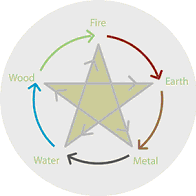The Greeks developed a model of the universe that posited four elements underlying all physical existence: earth, fire, water, and air. In their model, the yogis of India, following the Samkhya philosophy, included space as a fifth element. The yogis, however, extended the model to all experience, not just physical forms. In China, the pragmatic Daoist also saw five base elements; however, they noted a couple of key differences. The five elements in their model are earth, fire, water, metal, and wood. They developed this model from the patterns of the universe easily observable to anyone who watches.
The Elemental Cycle

Rain (water) causes plants (wood) to grow. These plants and trees are scorched in summer and feed the flames when fire comes. From the fire the plants turn to ash, which become earth. Within the earth are formed metal ores. Metals, when cold, cause water to condense, forming the rain that begins the creative cycle all over again.
Each element nourishes another element and controls a different element but in turn is controlled by a different element.
Here we find a universal method of checks and balances. Water promotes the existence of wood, which promotes fire, which burns things to the earth. In the earth we find metals, which through condensation promote the formation of water. [1] However, water douses or controls fire, which melts or controls metal, which cuts or controls wood, which plows or controls earth, which soaks up or controls water. [2] Harmony requires checks and balances. If any one element becomes too strong or too weak, imbalance occurs, illness sets in, and harmony is lost.
While these observations were noticed in the external world, the Daoist, like the yogis of India, associated these elements with everything experienced in life. Harmony in our internal world requires checks and balances as well. Physically we suffer if there is too much fire in our body or too little water. Health requires the five elements to be balanced.
The five elements became associated with the five directions, the five colors, five bodily tissues, five fluids, five solid organs, and five hollow organs.
|
Wood
|
Fire
|
Earth
|
Metal
|
Water
|
| East | South | Centre | West | North |
| Green | Red | Yellow | White | Black (or dark blue) |
| Tendons | Blood vessels | Muscles | Skin | Bones |
| Tears | Sweat | Saliva | Mucus | Urine |
| Liver | Heart | Spleen | Lung | Kidney |
| Gall Bladder | Small Intestines | Stomach | Large Intestines | Urinary Bladder |
| Anger | Joy/Fright | Worry | Sadness/Grief | Fear |
As seen above, the elements are also associated with emotions. There are seven emotions in the Daoist models: joy, fright (a sudden panicky feeling), worry, sadness, grief (or shock), fear, and anger. Any excess in these emotions can be harmful. This may seem strange to our Western sensibilities; how can we have too much joy? But in the Daoist model, an excess of joy can be just as harmful to our spirit as an excess of anger. The excess joy referred to here may best be seen in the youthful exuberance of a gang of revelers whooping it up in the streets late at night. Their joy creates disturbance all around them and within themselves too. Joy as defined here is not the deep bliss, our true nature, sought after by seekers of spiritual truth.
Strong emotional states are often triggered by imbalance in, or dysfunction of, our organs. When the checks and balances are not working, illness will arise. If the water function of the kidneys is impaired, the fire in the heart will be out of control, allowing fire to attack the metal of the lungs. Asthma and grief can result. A Chinese doctor may not look to a respiratory remedy for the asthma, but may rather prescribe tonics for the kidneys to cure the condition.
This is a very simplistic view of the Daoist model. We have only just scratched the surface. There are many excellent texts that describe the model more fully. The interested reader may wish to begin with The Web That Has No Weaver by Ted Kaptchuk to learn more about this topic. For now our journey takes us to visit the organs.
- — Follow the outer circle of the diagram clockwise to see how one element nourishes its neighbor.
- — In the diagram, looking inward follow the left-hand line to the opposite element to see how one element controls another. Following the right-hand line shows how each element is controlled by another.
(Next: The Organs )
